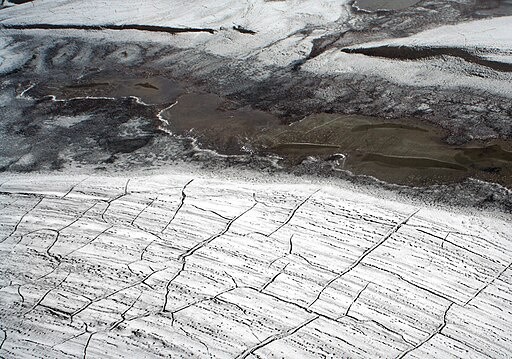Temperatures across the Arctic were found to be increasing two to four times faster than the global average. As a result, the region's warming thaws vast stretches of permafrost. Across the region, strange things are happening to the Arctic landscape, like the recently discovered migration of methane gas.

Methane Reserved Under the Ice
Under the frigid terrain of Svalbard, Norway, vast methane reserves have been found migrating below the thawing permafrost. The thick frozen ground forms a tight seal that has prevented methane deposits from escaping, but there is no guarantee that the greenhouse gas will not eventually escape. This finding is reported in the paper "Permafrost trapped natural gas in Svalbard, Norway."
Permafrost, or the frozen ground for at least two years, is widespread on Svalbard, a Norwegian archipelago in the Arctic Circle. Missions have drilled into the frozen soil while looking for fossil fuels. Although surveyors often accidentally hit pockets of natural gas, they still cannot determine the extent of these methane reserves.
Led by geologist Thomas Birchall from the University Center in Svalbard, Norway, a team of researchers used historical data from scientific and commercial boreholes to map the permafrost throughout Svalbard and locate the natural gas storage. They discovered methane deposits on the islands are much more common than previously thought. Since the archipelago has a geological and glacial history similar to the rest of the Arctic region, the scientists assume that the same could be true of other locations near the North Pole covered by permafrost.
The study also reveals that the permafrost seal on Svalbard is not uniform. Coastal areas were found to have a thinner crust of frozen soil because of the warmth brought by ocean currents. Meanwhile, permafrost in the lowlands is thick and saturated with ice, making it extremely good at sealing with self-healing ability. On the other hand, the dry environmental conditions in the highlands make the permafrost flakier and more permeable.
Climate Feedback Loops
While the permafrost is leak-proof, it may not stay that way, experts warn. It was revealed that Svalbard is one of the fastest-warming places on the planet. Its active permafrost layer, the upper few feet that seasonally thaw and refreeze, grows deeper with global temperatures.
Estimating the amount of methane trapped below can be tricky since it is difficult to access using only a few dozen boreholes. Based on the location where the gas flow was measured, it is estimated that the methane reserve could reach several million cubic feet.
The leakage from below permafrost is currently very low, according to Birchall. However, some factors like permafrost thawing and glacial retreat may trigger the natural gas to escape in the future.
Since the base of permafrost is undulating, it creates pockets between the permafrost and the underlying landscape where the greenhouse gas from biological and non-biological sources can accumulate and become trapped. If this permafrost seal disintegrates, it can start a chain reaction where the warming solid effect of methane would thaw more permafrost and release even more natural gas. This feedback loop can further accelerate global warming, permafrost melting, and methane emissions.
RELATED ARTICLE : Extreme Melting of Arctic Permafrost May Free-Trapped Ancient Viruses, Radioactive Waves
Check out more news and information on Permafrost in Science Times.










